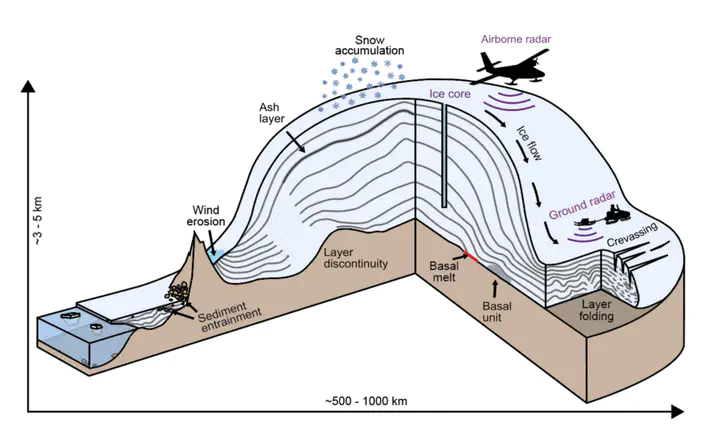Review Article: Antarctica’s internal architecture: Towards a radiostratigraphically-informed age–depth model of the Antarctic ice sheets

Abstract
Radio-echo sounding (RES) has revealed an internal architecture within Antarctica’s ice sheets that records their depositional, deformational and melting histories. Crucially, spatially-widespread RES-imaged internal-reflecting horizons, tied to ice-core age-depth profiles, can be treated as isochrones that record the age-depth structure across the Antarctic ice sheets. These enable the reconstruction of past climate and ice-dynamical processes on large scales, which are complementary to but more spatially-extensive than commonly used proxy records across Antarctica. We review progress towards building a pan-Antarctic age-depth model from these data by first introducing the relevant RES datasets that have been acquired across Antarctica over the last six decades (focussing specifically on those that detected internal-reflecting horizons), and outlining the processing steps typically undertaken to visualise, trace and date (by intersection with ice cores, or modelling) the RES-imaged isochrones. We summarise the scientific applications to which Antarctica’s internal architecture has been applied to date and present a pathway to expanding Antarctic radiostratigraphy across the continent to provide a benchmark for a wider range of investigations: (1) Identification of optimal sites for retrieving new ice-core palaeoclimate records targeting different periods; (2) Reconstruction of surface mass balance on millennial or historical timescales; (3) Estimates of basal melting and geothermal heat flux from radiostratigraphy and comprehensively mapping basal-ice units, to complement inferences from other geophysical and geological methods; (4) Advancing knowledge of volcanic activity and fallout across Antarctica; (5) The refinement of numerical models that leverage radiostratigraphy to tune time-varying accumulation, basal melting and ice flow, firstly to reconstruct past behaviour, and then to reduce uncertainties in projecting future ice-sheet behaviour.